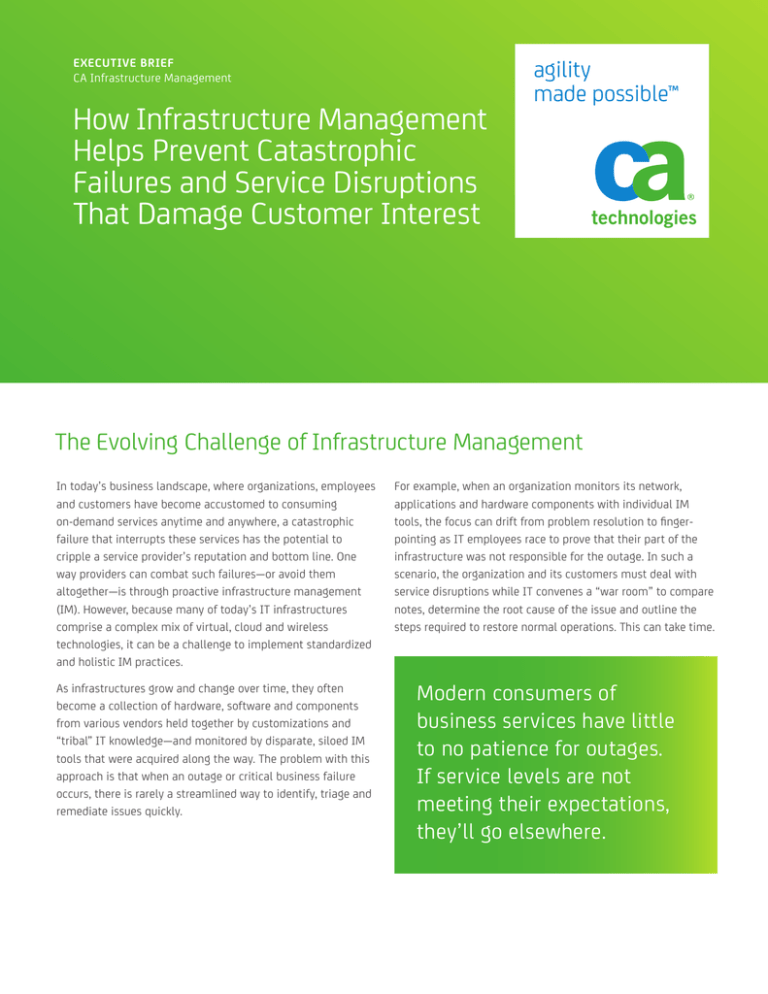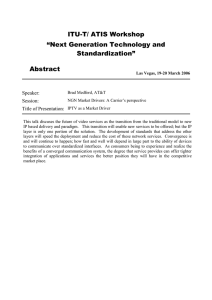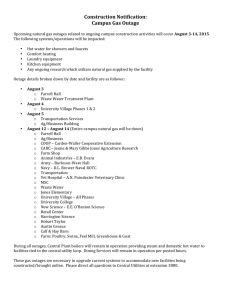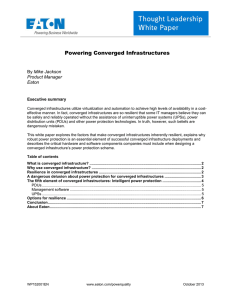
EXECUTIVE BRIEF
CA Infrastructure Management
How Infrastructure Management
Helps Prevent Catastrophic
Failures and Service Disruptions
That Damage Customer Interest
agility
made possible™
The Evolving Challenge of Infrastructure Management
In today’s business landscape, where organizations, employees
and customers have become accustomed to consuming
on-demand services anytime and anywhere, a catastrophic
failure that interrupts these services has the potential to
cripple a service provider’s reputation and bottom line. One
way providers can combat such failures—or avoid them
altogether—is through proactive infrastructure management
(IM). However, because many of today’s IT infrastructures
comprise a complex mix of virtual, cloud and wireless
technologies, it can be a challenge to implement standardized
and holistic IM practices.
As infrastructures grow and change over time, they often
become a collection of hardware, software and components
from various vendors held together by customizations and
“tribal” IT knowledge—and monitored by disparate, siloed IM
tools that were acquired along the way. The problem with this
approach is that when an outage or critical business failure
occurs, there is rarely a streamlined way to identify, triage and
remediate issues quickly.
For example, when an organization monitors its network,
applications and hardware components with individual IM
tools, the focus can drift from problem resolution to fingerpointing as IT employees race to prove that their part of the
infrastructure was not responsible for the outage. In such a
scenario, the organization and its customers must deal with
service disruptions while IT convenes a “war room” to compare
notes, determine the root cause of the issue and outline the
steps required to restore normal operations. This can take time.
Modern consumers of
business services have little
to no patience for outages.
If service levels are not
meeting their expectations,
they’ll go elsewhere.
Executive Brief: CA Infrastructure Management
Outages range from those that are short-lived and impact only
a few customers to those that are covered on the front page of
The New York Times business section. Regardless of their size,
they all have the potential to negatively impact business.
However, the good news is that the same IM strategies can be
used to prevent simple or catastrophic outages.
they’ll go elsewhere—which means reduced revenue and a
potentially damaged brand reputation for the offending
provider. That said, organizations can more proactively respond
to outages, ensure high service levels and avoid customer
attrition by:
Why is a proactive approach to IM important? Because modern
consumers of business services have little to no patience for
outages. If service levels are not meeting their expectations,
• Streamlining root-cause analysis of issues
• Developing a converged view of infrastructure performance
• Evolving IM capabilities alongside a changing infrastructure
Developing a Converged View of Infrastructure Performance
There is a very clear distinction between organizations that
manage infrastructure components individually and those that
have converged their IM practices: the former reactively
address issues after the fact, while the latter proactively
monitor the entire infrastructure and work to prevent
disruptions from even occurring.
For example, in a situation where three servers are driving an
application and one of the servers goes down, the organization
with the siloed view might not be alerted unless another
server fails and takes the application with it. On the other
hand, the company with the converged view can immediately
see that when the server goes offline, risk to service delivery
has significantly increased, and it can take steps to proactively
remediate, avoiding a potential failure and the flood of
customer support issues that come with it.
With a converged view of all infrastructure components, IT
employees can access actionable performance, availability,
flow, capacity and application-response information from a
single interface in real time, enabling them to quickly and
accurately remediate any issues before they disrupt employee
or customer services.
With a converged view of all infrastructure components, IT
employees can access actionable performance, availability, flow,
capacity and application-response information from a single
interface in real time, enabling them to remediate any issues
before they disrupt employee or customer services.
02
Executive Brief: CA Infrastructure Management
Streamlining Root-Cause Analysis of Issues
Oftentimes, organizations that monitor their infrastructures on
a component-by-component basis struggle to quickly and
accurately identify the root cause of an issue. This is because
siloed IM tools have limited abilities to correlate the
interdependencies of hardware, software and networks. As a
result, IT employees must spend time manually analyzing
performance data and triaging remediation activities on a
trial-and-error basis—which can slow time-to-resolution and
extend service downtime for employees and customers.
One way to streamline the root-cause analysis of issues is by
deploying an intelligent solution that correlates cross-silo
information and includes a visualization tool, such as a
real-time dashboard, that shows key performance indicators in
easy-to-understand gauges, tables and heat charts. When
used as part of a converged IM interface, a dashboard will
help pinpoint malfunctions amidst the myriad infrastructure
interdependencies and outline best-practice workflows for fast
remediation.
Evolving IM Capabilities Alongside a Changing Infrastructure
When it comes to reactive, siloed IM practices, it was the
gradual accumulation of point solutions that got many
organizations in trouble in the first place. So as infrastructures
continue to evolve and become more complex, it is imperative
that companies choose IM technologies that will not only
meet their needs today, but also scale and adapt to their IT
environments going forward.
In addition to helping “future proof” an infrastructure, a
scalable and flexible IM solution will enable organizations to
avoid a “rip and replace” scenario at the outset. For example,
they can choose a lightweight SaaS or on-premise deployment
that integrates with, and thus extends the life of, existing
assets and transition to a more unified, converged solution
over time—enabling an evolutionary approach to enhancing
existing infrastructure investments.
A truly flexible IM solution will:
What’s more, as customer demands for new and higherperforming services continue to increase, an IM solution with
a flexible architecture, high scalability and broad vendor
compatibility will help organizations avoid capacity and
throughput issues that can hinder service delivery by enabling
IT to address evolving infrastructure and customer needs.
• Be vendor-agnostic, enabling simple integration with
existing and future technologies
• Offer flexible deployment options, whether on-premise or
as software-as-a-service (SaaS)
• Boast an architecture that can scale to support high-density,
high-throughput environments
• Allow managed service providers to separate monitoring
environments for multi-tenant scenarios and provide
usage chargeback
03
Executive Brief: CA Infrastructure Management
Overcoming the “Not Us” Mindset
It should come as no surprise that in an ultra-competitive
business landscape, organizations cannot afford to lose
customers due to unfulfilled SLAs or frequent service outages.
And of course, they want to avoid truly news-worthy outages
at all costs. In addition to the immediate revenue hit, they risk
a damaged brand reputation that could quickly spread and
deter potential buyers in today’s always connected, socialmedia world.
However, for many companies that have never experienced a
catastrophic failure or business disruption, the prospect of
losing customers due to such an event is often viewed as an
intangible possibility that “could never happen to us.” As a
result, these organizations have no problem maintaining the
status quo with their siloed IM practices; however, when they
do this, they forfeit a number of potential benefits, including:
• Reduced total cost of ownership (TCO) – As organizations
standardize their IM practices, they can eliminate legacy
technologies and related license, maintenance and
overhead costs.
• Increased IT productivity – IT employees can spend less
time in war rooms triaging issues and more time on strategic
initiatives that contribute to revenue for the business.
• Accelerated issue resolution – Regardless of the severity of
the disruption, a converged IM solution helps organizations
resolve issues quickly so it can provide the service that
employees and customers demand.
For some organizations, being able to avoid business
disruptions—that according to them might never happen—
is not a powerful enough motivator on its own to drive a
converged IM project. That said, when this capability is
coupled with the aforementioned business benefits of reduced
TCO, increased productivity and accelerated issue resolution,
executives start to take notice. They understand that in
addition to helping develop a more proactive posture for
managing IT infrastructure, the right IM solution will enable
an organization to quickly and cost-effectively meet evolving
business and customer demands—now and in the future.
For many companies that
have never experienced a
catastrophic failure or
business disruption, the
prospect of losing customers
due to such an event is often
viewed as an intangible
possibility that “could never
happen to us.”
CA Technologies (NASDAQ: CA) provides IT management solutions that help customers manage and secure
complex IT environments to support agile business services. Organizations leverage CA Technologies software
and SaaS solutions to accelerate innovation, transform infrastructure and secure data and identities, from
the data center to the cloud. CA Technologies is committed to ensuring our customers achieve their desired
outcomes and expected business value through the use of our technology. To learn more about our customer
success programs, visit ca.com/customer-success. For more information about CA Technologies go to ca.com.
Copyright ©2013 CA. All rights reserved.




